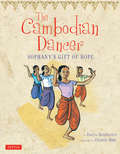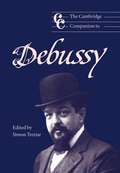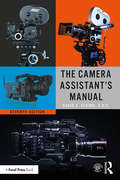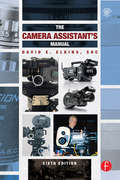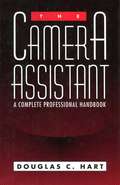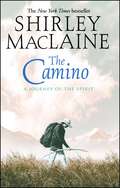- Table View
- List View
The Cambodian Dancer
by Christy Hale Daryn Reicherter Bophal PenhNot even the most terrible brutality can completely destroy the human spirit.In clear but simple language and beautiful illustrations, this Cambodian children's story communicates a sense of the joy, sadness, injustice and triumph that lives on in young Cambodian Americans. It shows that it is possible to overcome great hardship, and that a single decision can do much to heal one's self and others.The Cambodian Dancer is the true story of a Cambodian refugee-a dancer and teacher-who built a life in the US after fleeing the Khmer Rouge. She became a counselor to other Cambodian refugees and created a school of dance for children. Her gift of hope was to teach children in the Cambodian community the traditional dances of Cambodia so that young people growing up far away from the land of their ancestors would know about their culture.
The Cambodian Dancer
by Daryn ReicherterNot even the most terrible brutality can completely destroy the human spirit. In clear but simple language and beautiful illustrations, this Cambodian children's story communicates a sense of the joy, sadness, injustice and triumph that lives on in young Cambodian Americans. It shows that it is possible to overcome great hardship, and that a single decision can do much to heal one's self and others. The Cambodian Dancer is the true story of a Cambodian refugee--a dancer and teacher--who built a life in the US after fleeing the Khmer Rouge. She became a counselor to other Cambodian refugees and created a school of dance for children. Her gift of hope was to teach children in the Cambodian community the traditional dances of Cambodia so that young people growing up far away from the land of their ancestors would know about their culture.
The Cambridge Companion to Ballet
by Marion KantBallet is a paradox: much loved but little studied. It is a beautiful fairy tale; detached from its origins and unrelated to the men and women who created it. Yet ballet has a history, little known and rarely presented. These great works have dark sides and moral ambiguities, not always nor immediately visible. The daring and challenging quality of ballet as well as its perceived 'safe' nature is not only one of its fascinations but one of the intriguing questions to be explored in this 2007 Companion. The essays reveal the conception, intent and underlying meaning of ballets and recreate the historical reality in which they emerged. The reader will find new and unexpected aspects of ballet, its history and its aesthetics, the evolution of plot and narrative, new insights into the reality of training, the choice of costume and the transformation of an old art in a modern world.
The Cambridge Companion to Benjamin Britten, Billy Budd
by Mervyn CookeBilly Budd, based on Herman Melville's nautical allegory, is one of Britten's most challenging operas. This comprehensive guide considers the work from both literary and musical viewpoints. Melville's novella is discussed, as is the interpretation given to the novella by the librettists E. M. Forster and Eric Crozier. A detailed synopsis guides the reader through the musical and dramatic action of the opera and in a chapter devoted to the music, Britten's distinctive technique of tonal symbolism is analyzed to demonstrate the effectiveness of his musical response to the dramatic suggestions of Melville's story. The most important critical writings on Billy Budd are represented by an expanded version of Donald Mitchell's 1979 notebook on the opera. A final chapter charts the opera's stage history and fluctuating critical reception.
The Cambridge Companion to Bob Dylan
by Kevin J. H. DettmarA towering figure in American culture and a global twentieth-century icon, Bob Dylan has been at the centre of American life for over forty years. The Cambridge Companion to Bob Dylan brings fresh insights into the imposing range of Dylan's creative output. The first Part approaches Dylan's output thematically, tracing the evolution of Dylan's writing and his engagement with American popular music, religion, politics, fame, and his work as a songwriter and performer. Essays in Part II analyse his landmark albums to examine the consummate artistry of Dylan's most accomplished studio releases. As a writer Dylan has courageously chronicled and interpreted many of the cultural upheavals in America since World War II. This book will be invaluable both as a guide for students of Dylan and twentieth-century culture, and for his fans, providing a set of new perspectives on a much-loved writer and composer.
The Cambridge Companion to Choral Music
by André De QuadrosChoral music is now undoubtedly the foremost genre of participatory music making, with more people singing in choirs than ever before. Written by a team of leading international practitioners and scholars, this Companion addresses the history of choral music, its emergence and growth worldwide and its professional practice. The volume sets out a historical survey of the genre and follows with a kaleidoscopic bird's eye view of choral music from all over the world. Chapters vividly portray the emergence and growth of choral music from its Quranic antecedents in West and Central Asia to the baroque churches of Latin America, representing its global diversity. Uniquely, the book includes a pedagogical section where several leading choral musicians write about the voice and the inner workings of a choir and give their professional insights into choral practice. This Companion will appeal to choral scholars, directors and performers alike.
The Cambridge Companion to Debussy
by Simon TreziseOften considered the father of twentieth-century music, Debussy was a visionary whose influence is still felt. This Companion offers new insights into Debussy's character, his environment and his music, including challenging views of the roles of nature and eroticism in his life and music. While works in all genres are discussed, they are considered through the themes of sonority, rhythm, tonality and form, with closing chapters considering the performance and reception of his music in the first years of the new century.
The Cambridge Companion to Ravel
by Deborah MawerThis companion provides a comprehensive introduction to the life, music and compositional aesthetic of French composer Maurice Ravel (1875-1937). Leading international scholars offer a powerful reassessment of this most private and elusive musician, examining his work in detail within its cultural context. Marking the 125th anniversary of Ravel's birth, the volume explores the full range of his work--piano repertory, chamber works, orchestral music, ballets, songs and operas--and concludes by analyzing the performance and reception of his music, including previously untranslated reviews.
The Cambridge Companion to Shakespearean Comedy
by Alexander LeggattThis is an accessible, wide-ranging and informed introduction to Shakespeare's comedies and romances. Rather than taking each play in isolation, the chapters trace recurring issues, suggesting both the continuity and the variety of Shakespeare's practice and the creative use he made of the conventions he inherited. The first section puts Shakespeare in the context of classical and Renaissance comedy and comic theory, the work of his Elizabethan predecessors and the traditions of popular festivity. The second section traces a number of themes through Shakespeare's early and middle comedies, dark comedies and late romances, establishing the key features of his comedy as a whole and illuminating particular plays by close analysis. Individual chapters draw on contemporary politics, rhetoric, and the history of Shakespeare production. Written by experts in the relevant fields, the chapters bring the reader up to date on current thinking and frequently challenge long-standing critical assumptions.
The Cambridge Companion to the Actress
by Maggie B. Gale John StokesThis Companion brings together sixteen new essays which examine, from various perspectives, the social and cultural role of the actress throughout history and across continents. Each essay focuses on a particular stage in her development, for example professionalism in the seventeenth century; the emergence of the actress/critic during the Romantic period and, later on, of the actress as best selling autobiographer; the coming of the drama schools which led to today's emphasis on the actress as a highly-trained working woman. Chapters consider the image of the actress as a courtesan, as a 'muse', as a representative of the 'ordinary' housewife, and as a political activist. The collection also contains essays on forms, genres and traditions - on cross dressing, solo performance, racial constraints, and recent Shakespeare - as well as on the actress in early photography and on film. Its unique range will fascinate, surprise and instruct theatre-goers and students alike.
The Cambridge Companion to the Beatles
by Kenneth WomackFrom Please Please Me to Abbey Road, this collection of essays tells the fascinating story of the Beatles - the creation of the band, their musical influences, and their cultural significance, with emphasis on their genesis and practices as musicians, songwriters, and recording artists. Through detailed biographical and album analyses, the book uncovers the background of each band member and provides expansive readings of the band's music. - Traces the group's creative output from their earliest recordings through their career - Pays particular attention to the social and historical factors which contributed to the creation of the band - Investigates the Beatles' unique enduring musical legacy and cultural power - Clearly organized into three sections, covering Background, Works, and History and Influence, the Companion is ideal for course usage, and is also a must-read for all Beatles fans
The Cambridge Encyclopedia of Stage Actors and Acting
by Simon WilliamsActing is widely acknowledged to be the central art of the theatre and has a long and vibrant history. With over 1,000 entries, this is the first encyclopedia of stage actors and acting around the world. More than 100 renowned international contributors provide biographical, historical and technical information about actors both familiar and obscure whose work has been crucial in the development of acting methods and traditions from classical theatre to the present day. Entries on key directors, theorists and teachers and on the elements and genres of acting provide insights into the history of acting as an art and its current practice. Including a chronological list of actors that spans the past 2,000 years and many diverse countries and cultures, this Encyclopedia offers a fascinating and unique overview of acting onstage that will be of interest to anyone who attends or practises theatre.
The Cambridge Introduction to Comedy
by Eric Weitz'Laughter', says Eric Weitz, 'may be considered one of the most extravagant physical effects one person can have on another without touching them'. But how do we identify something which is meant to be comic, what defines something as 'comedy', and what does this mean for the way we enter the world of a comic text? Addressing these issues, and many more, this is a 'how to' guide to reading comedy from the pages of a dramatic text, with relevance to anything from novels and newspaper columns to billboards and emails. The book enables you to enhance your grasp of the comic through familiarity with characteristic structures and patterns, referring to comedy in literature, film and television throughout. Perfect for drama and literature students, this Introduction explores a genre which affects the everyday lives of us all, and will therefore also capture the interest of anyone who loves to laugh.
The Cambridge Introduction to Performance Theory
by Simon ShepherdWhat does 'performance theory' really mean and why has it become so important across such a large number of disciplines, from art history to religious studies and architecture to geography? In this introduction Simon Shepherd explains the origins of performance theory, defines the terms and practices within the field and provides new insights into performance's wide range of definitions and uses. Offering an overview of the key figures, their theories and their impact, Shepherd provides a fresh approach to figures including Erving Goffman and Richard Schechner and ideas such as radical art practice, performance studies, radical scenarism and performativity. Essential reading for students, scholars and enthusiasts, this engaging account travels from universities into the streets and back again to examine performance in the context of political activists and teachers, countercultural experiments and feminist challenges, and ceremonies and demonstrations.
The Cambridge Wagner Encyclopedia
by Nicholas VazsonyiRichard Wagner is one of the most controversial figures in Western cultural history. He revolutionized not only opera but the very concept of art, and his works and ideas have had an immeasurable impact on both the cultural and political landscapes of the late nineteenth and twentieth centuries. From "absolute music" to "Zurich" and from "Theodor Adorno" to "Hermann Zumpe," the vividly-written entries of The Cambridge Wagner Encyclopedia have been contributed by recognized authorities and cover a comprehensive range of topics. More than eighty scholars from around the world, representing disciplines from history and philosophy to film studies and medicine, provide fascinating insights into Wagner's life, career, and influence. Multiple appendices include listings of Wagner's works, historic productions, recordings, and addresses where he lived, to round out a volume that will be an essential and reliable resource for enthusiasts and academics alike.
The Camera Age: Essays on Television
by Michael J. ArlenEssays and articles by Arlen, about television broadcasting during the mid twentieth century.
The Camera Always Lies
by Hugh HoodFilmmaker Rose Leclair is beautiful, famous, and happily married. But when a new star actress begins commanding unwelcome amounts of attention--even, reportedly, from Rose's own husband--her life of privilege unspools. First published in 1967, The Camera Always Lies is an absorbing novel of Hollywood politics and one woman's struggle to survive them.
The Camera Assistant's Manual
by David E. Elkins SocExcel as a Cameraman in today’s evolving film industry with this updated classic. Learn what to do – and what NOT to do – during production and get the job done right the first time. This seventh edition covers the basics of cinematography and provides you with the multi-skill set needed to maintain and transport a camera, troubleshoot common problems on location, prepare for job interviews, and work with both film and digital technologies. Illustrations, checklists, and tables accompany each chapter and highlight the daily workflow of an Assistant Cameraman (AC), with expanded sections on problems and troubleshooting, updated formulas, tables, and checklists, as well as new information on the differences between working in the United States and UK and additional information on working with digital technology. This is a must-have for anyone looking to succeed in this highly technical and ever-changing profession. This book features a comprehensive companion web site that offers plenty of useful resources, including online tutorials that ACs can easily access while on location and supplementary downloadable forms and checklists.
The Camera Assistant's Manual
by David E. Elkins, SOCExcel as an Assistant Cameraman (AC) in today’s evolving film industry with this updated classic. Learn what to do—and what NOT to do—during production and get the job done right the first time. The Camera Assistant’s Manual, Sixth Edition covers the basics of cinematography and provides you with the multi-skill set needed to maintain and transport a camera, troubleshoot common problems on location, prepare for job interviews, and work with the latest film and video technologies. Illustrations, checklists, and tables accompany each chapter and highlight the daily workflow of an AC. This new edition has been updated to include: A fresh chapter on the entry level camera positions of Camera Trainee/Production Assistant Coverage of emerging iPhone apps that are used by filmmakers and ACs on set An updated companion website offering online tutorials, clips, and techniques that ACs can easily access while on location (www.cameraassistantmanual.com) All new sample reports and forms including AC time cards, resumé templates, a digital camera report, and a non-prep disclaimer Instruction and custom forms to help freelance filmmakers keep track of daily expenses for tax purposes The Camera Assistant’s Manual, Sixth Edition is an AC's bible for success and a must-have for anyone looking to prosper in this highly technical and ever-changing profession.
The Camera Assistant: A Complete Professional Handbook
by Douglas HartVeteran camera assistant Doug Hart describes in this comprehensive technical guide all of the important facets and duties of the first and second camera assistants' jobs. Whether it is feature films, episodic television, documentaries, commercials, or music videos, The Camera Assistant: A Complete Professional Handbook explains both the practice and theory behind it with a concentration on technique rather than equipment. In addition, personal anecdotes from the author's years behind and beside the camera provide insight into this demanding field. Key topics include film formats and aspect ratios, testing lenses and camera equipment, focus theory, film loading and labeling, scene blocking, marking actors, shooting tips, slating, paperwork, equipment maintenance, set etiquette, and finding work. This is not a camera equipment handbook; it is a comprehensive procedures manual which describes and explains the most important responsibilities of the camera assistant on the set, the theory behind the practice, and the methods that get the job done properly and keep the assistant frequently employed. Douglas C. Hart has been a freelance first-camera assistant on feature films, documentaries, television shows, and commercials for more than 20 years, including 10 years (and 10 films) as first-camera assistant to Gordon Willis, ASC, as well as work in 42 states and 26 foreign countries. His work includes Presumed Innocent, Hannah and Her Sisters, The Cosby Mysteries, and CBS's Central Park West. He is a member and former president of the International Photographers Local 644, IATSE, and teaches the Camera Assistant Workshops at the International Film and Television Workshops in Rockport, Maine.
The Camera-Eye Metaphor in Cinema (Routledge Advances in Film Studies)
by Christian QuendlerThis book explores the cultural, intellectual, and artistic fascination with camera-eye metaphors in film culture of the twentieth century. By studying the very metaphor that cinema lives by, it provides a rich and insightful map of our understanding of cinema and film styles and shows how cinema shapes our understanding of the arts and media. As current new media technologies are attempting to shift the identity of cinema and moving imagery, it is hard to overstate the importance of this metaphor for our understanding of the modalities of vision. In what guises does the "camera eye" continue to survive in media that is called new?
The Camera-shy Cupid
by Mary Fanjoy ReidBree Gaston is a script reader for the Boise Broadcasting Association. But the eccentric director of the sitcom "The Camera-Shy Cupid" desperately needs an extra actress. Before Bree can blink, she finds herself on the set in a ridiculously tight dress and high heels, being introduced to her sitcom boyfriend, Richard Bell. Much to her surprise, she is offered a regular contract with the show. After a passionate kiss, Richard and Bree realize that they are not just acting. But before they can figure out their feelings, Philippe Descartes, a suave advertising executive, returns from France and begins actively pursuing Bree. And Sandy Masterson, a beautiful blond actress, is determined that she and Richard will be much closer than friends. Will the story of "The Camera-Shy Cupid" have a happy ending both on and off the set? Romantic sparks are flying, there's humor around every corner and the role of and work demands of extras in a television series are revealed. Mood swings abound and the story is fast paced.
The Camino
by Shirley MaclaineIt has been nearly three decades since Shirley MacLaine commenced her brave and public commitment to chronicling her personal quest for spiritual understanding. In testament to the endurance and vitality of her message, each of her eight legendary bestsellers -- fromDon't Fall Off the MountaintoMy Lucky Stars-- continues today to attract, dazzle, and transform countless new readers. Now Shirley is back -- with her most breathtakingly powerful and unique book yet. This is the story of a journey. It is the eagerly anticipated and altogether startling culmination of Shirley MacLaine's extraordinary -- and ultimately rewarding -- road through life. The riveting odyssey began with a pair of anonymous handwritten letters imploring Shirley to make a difficult pilgrimage along the Santiago de Compostela Camino in Spain. Throughout history, countless illustrious pilgrims from all over Europe have taken up the trail. It is an ancient -- and allegedly enchanted -- pilgrimage. People from St. Francis of Assisi and Charlemagne to Ferdinand and Isabella to Dante and Chaucer have taken the journey, which comprises a nearly 500-mile trek across highways, mountains and valleys, cities and towns, and fields. Now it would be Shirley's turn. For Shirley, the Camino was both an intense spiritual and physical challenge. A woman in her sixth decade completing such a grueling trip on foot in thirty days at twenty miles per day was nothing short of remarkable. But even more astounding was the route she took spiritually: back thousands of years, through past lives to the very origin of the universe. Immensely gifted with intelligence, curiosity, warmth, and a profound openness to people and places outside her own experience, Shirley MacLaine is truly an American treasure. And once again, she brings her inimitable qualities of mind and heart to her writing. Balancing and negotiating the revelations inspired by the mysterious energy of the Camino, she endured her exhausting journey to Compostela until it gradually gave way to a far more universal voyage: that of the soul. Through a range of astonishing and liberating visions and revelations, Shirley saw into the meaning of the cosmos, including the secrets of the ancient civilizations of Atlantis and Lemuria, insights into human genesis, the essence of gender and sexuality, and the true path to higher love. With rich insight, humility, and her trademark grace, Shirley MacLaine gently leads us on a sacred adventure toward an inexpressibly transcendent climax. The Caminopromises readers the journey of a thousand lifetimes.
The Campus Queen in Literature and Culture: Prom Queen Profiles
by Jamie Hammel CulverThe Campus Queen in Literature and Culture: Prom Queen Profiles explores the nuanced relationship between femininity and power and provides a scholarly framework for understanding the evolution of the prom queen’s archetypal ubiquity. Semantically, the titles are nearly synonymous—prom queen, homecoming queen, winterfest princess—as all denote the longstanding tradition in the United States of conferring royal status upon teenage popularity. Yet whatever we call it, high school royalty remains one of the most paradoxical realities of youth culture, for as fervently as it gets dismissed and discredited, it is just as frequently revered and respected. A physical manifestation of the student body’s collective hegemonic efforts, the campus queen occupies a significant space in literature and culture, excavating truths both timeless and telling. A signature survey of the genre, this study traces the historical underpinnings and cultural implications of the campus queen, examining the longevity of the archetype and ultimately reimagining the narrative for future generations.
The Canadian Horror Film
by André Loiselle Gina FreitagFrom the cheaply made "tax-shelter" films of the 1970s to the latest wave of contemporary "eco-horror," Canadian horror cinema has rarely received much critical attention. Gina Freitag and André Loiselle rectify that situation in The Canadian Horror Film with a series of thought-provoking reflections on Canada's "terror of the soul," a wasteland of docile damnation and prosaic pestilence where savage beasts and mad scientists rub elbows with pasty suburbanites, grumpy seamen, and baby-faced porn stars.Featuring chapters on Pontypool, Ginger Snaps, 1970s slasher films, Quebec horror, and the work of David Cronenberg, among many others, The Canadian Horror Film unearths the terrors hidden in the recesses of the Canadian psyche. It examines the highlights of more than a century of Canadian horror filmmaking and includes an extensive filmography to guide both scholars and enthusiasts alike through this treacherous terrain.
